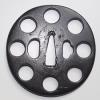-
Posts
159 -
Joined
-
Last visited
-
Days Won
1
Mushin last won the day on August 5
Mushin had the most liked content!
About Mushin

- Birthday January 1
Profile Information
-
Gender
Male
-
Location:
USA
-
Interests
Soshu, Bizen, Jingo, Higo, Owari San Saku
Profile Fields
-
Name
Bobby B
Recent Profile Visitors
2,575 profile views
Mushin's Achievements
-
Sorry, don't see Bizen unless the nakago was tortured and disfigured, which I don't see. And I don't see Heianjo Nagayoshi either. Like Robert S said above, either a fake or some other obscure Nagayoshi
-
Good question. Many of us would like to know the answer to that because there were several excellent examples that were passed over. “Why” is the big question. Some have theories, but there is no definitive answer. The current Honbu and their decisions are a mystery to the most ardent NBTHK watchers. But in your case, I think you have to be realistic. Besides, since Washington’s introduction of global tariffs, shipping swords back from Japan has been extremely problematic. I think patience is the best approach now while watching how the next few Juyo sessions go. So far, we have seen few surprises from what has been recently awarded Juyo and more from those that have been rejected.
-
So, Michael, In recent years, Kanenobu has become a new go to for attributions for a nice but not top class Naoe Shizu blade. But this is different from Shigaseki Kanenobu, who is not as well-regarded by collectors or the Honbu. As Jussi pointed out there are only three Juyo awarded to the smith. And I am not sure that Jussi has the data of how many TH and Hozon papers are out there awarded to him by comparison because of the massive volume of swords produced during the Muromachi, especially in Mino. I think you should reach out to folks who watch the trends in the Shinsa team to see how much they might have opened to great works by Muromachi Sengoku-era Mino smiths. I would suggest perhaps, Ray Singer or Hoshi or even Markus. I would hate to see you go through the stress and expense of shipping a blade into Japan and then paying somebody to submit it on your behalf if it’s going to not make it past the first round only because of institutional bias. And then having to wring your hands while waiting for your sword to come back. Darcy used to have an algorithm and formula he would use to assess a sword’s chances of making it through Juyo and then Tokubetsu Juyo, which I don’t know if he handed off to anybody before his passing. All I can say, based on what I am seeing, is that the last Shigaseki Kanenobu that passed Juyo was a katana in session 58, at least 23 years ago. Don’t want to rain on your parade or dash your hopes, it just doesn’t bode well. But to be honest, a sword doesn’t have to pass Juyo to be a Smith’s masterwork and some of my favorites blades only have Hozon papers, and I am ok with that.
-
No, he is not as far as I know but if you are interested DM with your email and I can connect the two of you. Robert Hughes should be here and he possibly can help get Tanobe-sensei to take a look at your research question. Fingers crossed!
-
Might also want to try reaching out to Bill Miller in Atlanta. If I am not mistaken, he has one of the biggest Satsuma collections in the world. Then there is Tanobe-sensei, who is also from he area and a collector of Satsuma blades. Robert Hughes might be able to help you direct questions to Tanobe. Best of luck.
-
While you are technically right, Michael, I think, as Jussi has shown above, Fujishiro missed out on several smiths who were known and regarded by scholars of the past. A good example is in the Sa School. For instance, several of the top seven students of Samonji, including Hiroyoshi and Sadayuki, are not even mentioned in Fujishiro. And Yukihiro, among Sa's very first students, and the only Sa School student with a Kokuho blade, is rated as just Jo-Saku, despite scholars saying his work was, of all Samonji's students, the closest to his master's work. Now, it's not my intention to denigrate Fujishiro, just to note that there is more to many of these smiths than whether or not they are mentioned in his books. Thus, as Jussu showed above, a Fujishiro ranking is not the only factor in the NBTHK's decisions.
-
I have seen a Juyo Bizen Osafune Morisuke in Enbun-Joji style from the mid-Nambokucho. It is in a friend's collection. The smith is rated Chujo Saku.It's a really nice blade in koshirae. I am not sure if that rule applies to high-quality older swords from the Heian, Kamakura and Nanbokucho time periods when production and quality values were overall very high. Also remember that while Fujishiro rankings are widely accepted, they are far from perfect or universally agreed upon. There are several instances of good smiths having been given lower rankings because Fujishiro either never saw their work or saw only a few examples that might not have been the best samples.
-

What makes a sword a masterpiece?
Mushin replied to Hoshi's topic in General Nihonto Related Discussion
Wow. That's a tough question. And while beauty is ultimately in the eye of the beholder, we all recognize certain aspects of mastery that we respond to. I would answer that by saying it’s an imperfect and complex, but harmonious balance of multiple aesthetic, technical and even spiritual elements. A truly great Nihonto should embody an artistic vision of form and function that raises it above a mere tool and sets it apart as an effort to harness the beauty of nature tamed or unleashed by the hand of man. It needs to embody depth, refinement, and presence that transcend craftsmanship alone. These qualities might vary from school to school, and sword to sword. For example. a great Soshu blade will exhibit different qualities than a great old Bizen sword. It some cases it’s the interplay of nie and nioi combined with a refined but vigorous hada. It also changes with shape and size. A tanto offers a different presence than a tachi where the aesthetics and balance of one does not translate to the other. For me, a great sword possess a serene nobility and a sense of a calm imbued with a coiled energy, a lethal elegance. It's a balance of contradictions. In fact, I think it will always be a contradiction because at its heart I think that is what the Japanese warrior aesthetic aimed for: beauty AND lethality. It’s funny as I am writing this, it’s clear that it’s hard to move away from fuzzy language and sometimes difficult to grasp, let alone articulate, concepts. We are moving into the realm of art philosophy. Ultimately, it’s like the SCOTUS definition of pornography: you’ll know it when you see it. And sometimes you can only recognize it by looking at a lot of it. LOL -

Increasing Gold Membership numbers?
Mushin replied to Brian's topic in General Nihonto Related Discussion
I think people will pay if: 1) They sense brand value, belonging and "exclusiveness" 2) There are perks to membership These days there sufficient third party companies that can print or embroider t-shirts, hats, mugs, tote bags, etc. that are exclusive to your corporate clients. You can also use Fiver to have somebody design these for you for literally five bucks or thereabouts. Or maybe on of our more creative members can do this. Submit the designs and colorist the printing company and then sit back. These are offered to the general public on a special page maintained by the company, at set prices ($15 to $35) , and then you can offer discounts to your paying members ($12-$15). You don't have to do anything as once you submit the designs, they produce and ship, handle order processing, etc. and give you a cut. Think of it like Lulu but for stuff not books. It helps raise money as well as build a brand and attract newcomers. These are true and tried and they help groups such as ours. This is but one idea. There are many out there. -
Very exciting indeed. It’s like watching a movie on the edge of our seat, waiting to see how it’s going to turn out. 🤞🏻
-
Pick up something interesting, Brian?
-

Advice for new collectors from an old dog
Mushin replied to R_P's topic in General Nihonto Related Discussion
I am very familiar with the mindset that if a sword isn’t Juyo, why bother—but I don’t share it. I recently sought the opinion of a good friend for his thoughts about a blade I was debating getting, and he asked me if I’d be content owning a sword that would never go Juyo. For me, the answer is yes, but not because I don’t care or don’t aspire to them. Truth is, I do own a few Juyo, and one is my all-time favorite. But right on its heels it is a Hozen token blade I bought for $2,000. If my house were on fire, those are the two I’d grab. And if I only managed to reach the Hozon, I’d be ok with that. The Hozon will likely never be Juyo, and that’s fine—papers don’t change what a sword is or why I like it. Darcy even noted this fact. (See his “ladder fallacy” posts.) Papers don’t change a blade. What matters to me is the artistry, the history, the workmanship, and the smith—not what certificate it might carry. But that said, it’s important to recognize that Juyo blades are special. Whatever you feel about Juyo swords there is something everybody should keep in mind about them: they serve as recorded works of art and as such are available to everybody to study and learn from. That’s a real contribution to posterity. But dismissing everything else as “lesser,” or sneering at Juyo as toys for rich collectors, are just opposite sides of the same bad coin. I know some collectors who (wrongly) dismiss Juyo blades as playthings of spoiled rich collectors. They disparage Juyo blades and those who like them because they see them and those who want them as elitist. This too is BS and it needs to stop. In the end, this is a hobby we should celebrate, not fight over. Love what you love, share what excites you, and respect that others might feel differently. Seriously, people. This is a cool hobby. Remember that always. -
Hokke, there is some truth to this but it is far from universal. Big dealers, and those with lots of international clientele, pretty much post inventory daily to some degree for all to see once the work is photographed and a write up is complete. Good example is Aoi Art, which pretty much publishes several pieces daily in English, Japanese and Chinese simultaneously. Any delay between acquiring a piece and posting it usually involves the time it takes to scan the work and make an oshigata. Eirakudo.shop puts up one usually very decent sword or fitting everyday, and, at the lower levels, nipponto.co.jp usually posts two or three everyday, with the occasional nice surprise. At least two (Choshuya.co.jp and samurai-nippon.net,) release monthly or bimonthly catalogues -- one in the post and one electronically -- to all those who sign up (and pay a small fee.) That said, what is true is what's online usually represents just a fraction of their total inventory, and the very best swords, or should I say those by smiths with the biggest name cache, are often not listed until after they are first shown to top clients or after DTI. (I get the impression that as top pieces are becoming more difficult to source, they are put aside for DTI, which is where the best swords and fittings they have gotten over the previous year are showcased. I'd love to know what percentage of these dealers' annual sales are at DTI.) Most of those top pieces are made initially available to small groups because of the size of the price tag. Some top sites that used to post top offerings several times a week, like Iidakoeno and Tsuruginoya, now post just decent pieces a few times a year, and some haven't posted new stuff in ages. I wouldn't even know they were still in business if I didn't see their offerings in the DTI catalogue. Several smaller and regional dealers though do operate like Hokke says, only posting online what isn't selling in their shop. While it could a business strategy, I suspect it might really be because they lack the staff to do all the preparatory work or are older and aren't computer literate.
-
Steve. DM on its way.









